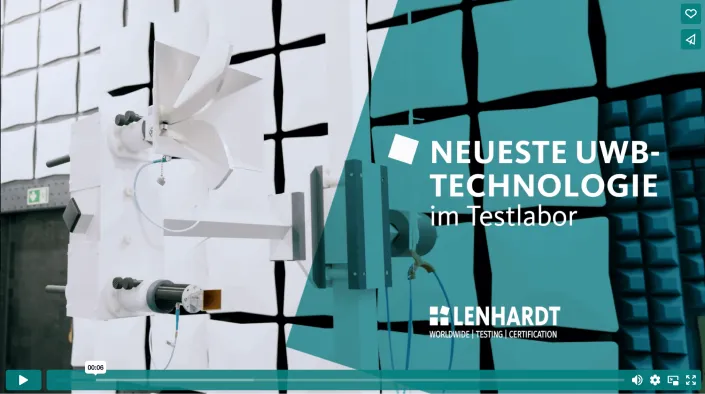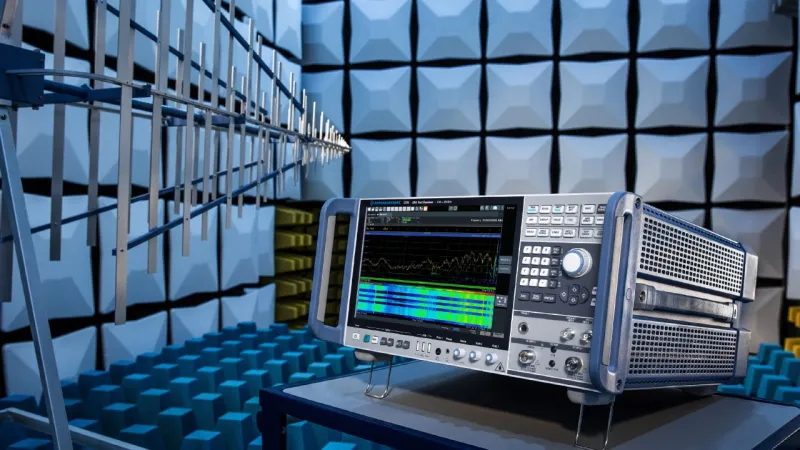
Funkprüfungen für weltweiten Marktzugang
Wir bieten internationale Prüfungen und Zertifizierungsdienste an, die auf Ihre speziellen Bedürfnisse zugeschnitten werden können. Mit unserer Erfahrung und unserem Fachwissen helfen wir Ihnen, Ihre Drahtlostechnologie schnell und effizient auf den Markt zu bringen und sicherzustellen, dass alle erforderlichen Anforderungen erfüllt werden.Leistungen
Regulatorische Funkprüfungen bei IB-Lenhardt AG
Unsere regulatorischen Prüfdienstleistungen decken ein breites Spektrum an Funktechnologien ab, wie z.B. WLAN, Bluetooth, drahtlose Energieübertragung, Ultra Wideband, DAB/DVB und Radartechnologien. Ein unkomplizierter Marktzugang solcher Produkte erfordert zuverlässige und unkomplizierte Zertifizierungsprozesse.
Prüfung von Funkgeräten nach der EU-Funkgeräterichtlinie (RED 2014/53/EU) sowie den regulatorischen Anforderungen in den USA, Kanada und Japan
Hochwertige Prüfungen verschiedener Frequenzbereiche (ISO 17025:2018), Funk bis 500 GHz (RF), Elektromagnetische Verträglichkeit (EMV), Elektrische Sicherheit (Safety)
Qualifizierte und erfahrene Experten unterstützen Ihren Projektstart, insbesondere die Vorbereitung der benötigten Prüflinge für den Prüfprozess
Webbasierte Software TAMSys®, die ein hervorragendes Management Ihrer Testprojekte ermöglicht: - Verfolgen Sie den Projektstatus in Echtzeit und von jedem Ort aus - Überwachen Sie laufende Projekte - Haben Sie immer Testberichte und unterstützende Dokumente zur Verfügung
Charakterisierung von Kfz-Radomen (Prüfung der EIRP-Ausgangsleistung mit und ohne Radom)
Benötigen Sie Unterstützung?
Kontaktieren Sie unseren Experten für Funkprüfungen:
Videos
Funkprüfungen im Labor
In unserer Videoreihe stellen wir wichtige Innovationen in der 78 GHz Technologie für Automobil-Radarsysteme vor und zeigen, wie wichtig Präzision und Leistung bei UWB-Messungen für die Zukunft sind. Erfahren Sie mehr über die Leistungsfähigkeit von Labortests für Industrieroboter und deren Anwendungen.



KfZ-Funkprüfungen
Radar Performance
Wir bieten die folgenden Funkprüfungen für die Produktzertifizierung in der Automobilindustrie an:

Vorteile, mit uns zu arbeiten
Exportieren Sie Ihre Wireless-Produkte weltweit
Mit unserer hochmodernen Ausstattung in unserem DAkkS-akkreditierten Labor sind wir in der Lage, den Zertifizierungsprozess Ihres Wireless-Produktes umfassend zu unterstützen. Das Tochterunternehmen IBL-Lab GmbH unterstützt die IB-Lenhardt AG und KL-Certification bei Typzulassungsprojekten sowie bei Zertifizierungen in der EU (NB), USA (TCB), Japan (RCB) und Kanada (FCB).
Diese einzigartige Konstellation ermöglicht eine schnelle und transparente Zertifizierung und damit einen schnellen weltweiten Marktzugang für Ihre Produkte. Nehmen Sie noch heute Kontakt mit uns auf.

Insight Lab
Unsere RF-Laborausrüstung
In unserem Prüflabor verwenden wir das TS8997 von Rohde & Schwarz, ein anerkanntes regulatorisches Testsystem für drahtlose Geräte. Es misst mit höchstem Automatisierungsgrad Technologien, die hauptsächlich in drahtlosen Breitbandgeräten im 2,4-GHz- und 5-GHz-Band eingesetzt werden, mit maximaler Effizienz bis hin zu Geräten im 7,5-GHz-ISM-Band. Zu den genannten Technologien gehören zum Beispiel WLAN, Bluetooth, Wireless Video Broadcast, Funkfernsteuerungen und IoT-Geräte. Sie müssen Konformitätstests gemäß ETSI EN 300328 für das 2,4-GHz-Band und ETSI EN 301893 für das 5-GHz-Band unterzogen werden. Die Funkmesstechnik von Rohde & Schwarz dient der gesetzlich vorgeschriebenen Prüfung von Geräten nach ETSI und FCC für ISM-Bänder.
Weltweite Zertifizierungen
IBL-Lab GmbH: Vollständig akkreditiertes Labor
Durch den Konformitätsnachweis unseres Prüflabors der IBL-Lab GmbH, mit der Akkreditierung DIN EN ISO/IEC 17025:2018, wird transparent bestätigt, dass Ihre durch uns geprüften Funkgeräte die notwendigen Qualitätsstandards erfüllen.
In unserem Prüflabor können Hochfrequenzprüfungen nach den folgenden gesetzlichen, globalen Anforderungen durchgeführt werden:
CE (Europa)
Bereit für den europäischen Markt
FCC (USA)
Abwicklung des US-Zulassungsverfahrens
ISED (Kanada)
Ihr Weg zum kanadischen Markt
MIC (Japan)
Erhalten Sie Ihre Typenzulassung für Japan
Prüfbereiche
Wir bieten umfassende Prüfdienste für die folgenden drahtlosen Technologieprodukte an:
Radar 24 GHz, 64 GHz, 77 GHz, 79 GHz, UWB
Funkschlüssel 315 MHz, 433 MHz, 868 MHz
Keyless Go 125 kHz, 13,56 MHz
Reifendruck-Sensoren 125 kHz, 315 MHz, 433 MHz, 868 MHz
Entertainment 2,4 GHz
Radar 64 GHz, Tankfüllstand, Positions-Radar
Wireless-M-Bus 315 MHz, 433 MHz, 868 MHz
Wireless-CAN-Bus 2.4 GHz
RFID + NFC 125 kHz, 13.56 MHz, 868 MHz
UWB Geräte 24 GHz, 60 GHz, 79 GHz
WirelessHD 60 GHz
WLAN 2.4GHz, 3 GHz, 5 GHz, 10 GHz
Bluetooth 2.4 GHz
Zigbee 868 MHz, 2.4 GHz
Europäische Union
Funkstandards der Europäischen Union
Die folgenden Normen sind die in Europa am meisten verbreiteten. Sie werden in der Europäischen Union angewendet und vom ETSI (European Telecommunications Standards Institute) kontrolliert.
ETSI EN 300 220
Geräte mit geringer Reichweite, die im Frequenzbereich von 25 MHz bis 1.000 MHz arbeitenETSI EN 300 330
Funkgeräte mit geringer Reichweite; Funkanlagen im Frequenzbereich von 9 kHz bis 25 MHz und Induktionsschleifensysteme im Frequenzbereich von 9 kHz bis 30 MHz; Harmonisierte Norm, die die wesentlichen Anforderungen des Artikels 3.2 der Richtlinie 2014/53/EU abdecktETSI EN 300 328
Breitbandübertragungssysteme; Datenübertragungseinrichtungen für den Betrieb im 2,4-GHz-Band; Harmonisierte Norm für den Zugang zum FunkspektrumETSI EN 302 065-X
Geräte mit geringer Reichweite, die Ultrabreitband-Technologie verwenden; Harmonisierte Norm, die die wesentlichen Anforderungen des Artikels 3.2 der Richtlinie 2014/53/EU abdecktETSI EN 302 264
Short Range Devices; Transport- und Verkehrstelematik; Radargeräte mit geringer Reichweite, die im Frequenzband 77 GHz bis 81 GHz arbeiten; Harmonisierte Norm, die die grundlegenden Anforderungen des Artikels 3.2 der Richtlinie 2014/53/EU erfülltETSI EN 301 091-X
Elektromagnetische Verträglichkeit und Funkspektrum-Angelegenheiten; Geräte mit geringer Reichweite; Straßentransport und Verkehrstelematik; Radargeräte, die im Bereich von 76 GHz bis 77 GHz arbeiten
Internationale Funkstandards
Weltweite Produktkonformität
Gerne führen wir auf Ihre speziellen Anforderungen zugeschnittene internationale Standardprüfungen durch und unterstützen Sie bei der Evolution Ihres Funkproduktes durch entwicklungsbegleitende Prüfungen.
USA: FCC 47 CFR Part 015
Hochfrequenzgeräte (Messungen bis zu 500 GHz)USA: FCC 47 CFR Part 095
Persönliche Funkdienste (einschließlich digitaler Geräte)—Grenzwerte und MessverfahrenKanada: RSS-Gen
Allgemeine Anfordeurngen an die Konformität von FunkgerätenKanada: RSS-251
Fahrzeugradar und stationäres oder mobiles Flughafenradar im Frequenzband 76-81 GHzKanada: RSS-210
Lizenzbefreite Funkgeräte: Geräte der Kategorie IKanada RSS-220
Geräte mit Ultrabreitband-TechnologieJapan: Radio Law
Spezifzierte Funkanlagen, die mit einer Frequenz unter 3 THz betrieben werden
Häufig gestellte Fragen
Alles, was Sie über die Prüfung von Funktechnologie wissen müssen
- Warum ist die Prüfung und Zertifizierung wichtig?
-
Funkprüfungen für drahtlose Technologien wie RFID, Kurzstreckengeräte, Wi-FI, ZigBee, Bluetooth, LTE oder NFC sind wichtig, um sie auf den globalen Märkten einführen zu können. Professionelle Prüfungen und die daraus resultierende Zertifizierung gewährleisten die Einhaltung gesetzlicher und normativer Vorschriften, wie z.B. der Funkrichtlinie 2014/53/EU. Geprüft werden die Einhaltung von Grenzwerten und die Störanfälligkeit, aber auch, ob ein drahtloses Produkt auf den richtigen Frequenzen in der HF-Umgebung sendet. Die Wireless Radio Testing and Certification sichert die Zulassung des jeweiligen Produkts für ein bestimmtes Land.
- Welche Produkte benötigen eine Funkprüfung?
-
Während die EMV-Prüfung für alle elektronischen Geräte und Systeme erforderlich ist, ist die Funkprüfung für Produkte erforderlich, die drahtlose Technologien wie RFID, WLAN, Bluetooth, Radar oder Ultrabreitband verwenden.
- Was bedeutet die Abkürzung ETSI?
-
ETSI steht für European Telecommunication Standards Institute (Europäisches Institut für Telekommunikationsnormen). Es ist eine der drei großen Normungsorganisationen in Europa, die für die europäische Normung im Bereich der Telekommunikation zuständig ist.
RF Standards

Kontaktieren Sie uns
Regulatorische und performante Labortests
Mit unserer langjährigen Erfahrung garantieren wir zuverlässige und schnelle Prüf- und Zertifizierungsleistungen, um Ihre Funkprodukte erfolgreich auf den Weltmarkt zu bringen. Die Experten der IB-Lenhardt AG und IBL-Lab GmbH sind immer für Sie da. Nehmen Sie Kontakt mit uns auf und vereinbaren Sie Ihren Prüfungstermin.